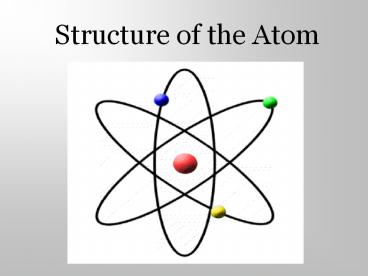Structure of the Atom - PowerPoint PPT Presentation
1 / 22
Title: Structure of the Atom
1
Structure of the Atom
2
- Elements
- form every object in the world
- have characteristic properties including
- State (solid, liquid, gas)
- Boiling/melting points
- Density
- Solubility
3
Periodic table an organized listing of all
known elements arranged by increasing atomic
number. John Dalton father of the atomic
theory Atomic theory all matter is made up of
tiny particles called atoms Matter anything
that has mass and volume. (Mass is determined
bythe amount of atoms in it) (Volume means - how
much space it covers.)
4
tom lehrer's the element song Atom the smallest
particle of an element that still has all the
properties of that element.
5
Parts of an atom 1. nucleus center part that
contains protons neutrons 2. energy
shells/levels contain the orbiting electrons
3 subatomic particles 1. proton 2. neutron 3.
electron
6
- 1. proton
- positive charge
- located in nucleus
- determines identity
- of element.
- ALL atoms of an element
- have the same number of protons.
- 2. neutron
- neutral charge
- located in nucleus
- adds mass
- Isotopes are atoms of the same element with
different number of neutrons.
7
- 3. electron
- negative charge
- located in energy shell
- determines physical chemical properties of
element.
8
- READING THE PERIODIC TABLE
Atomic number
8
O
Chemical symbol
Atomic mass
15.99
Atomic number equal to the number of protons
Atomic mass number the average mass of the
elements isotopes. Always round to nearest
whole number! (Most of the mass of an atom comes
from protons neutrons)
9
Atomic number number of protons in the nucleus
(p) It is also equal to the number of electrons
(e-) Carbon (C) atomic number 6
protons 6 electrons 6 Calcium
(Ca) atomic number 20
protons 20 electrons ?
10
Neutrons To find neutrons, subtract the atomic
number from the atomic mass. (Remember to round
the atomic mass first.) atomic mass (rounded) -
atomic number number of neutrons. Example
Fluorine 19 (atomic mass) 9 (atomic number)
10 neutrons.
11
Example Nickel (Ni) atomic number 28
protons (p) 28 electrons (e-)
28 atomic mass 59 neutrons
59 28 31
12
Magnesium (Mg) atomic number 12
protons (p) 12 electrons (e-)
12 atomic mass 24 neutrons
24 12 12
13
Bohrs model a diagram of an atom showing the
location AND the number of protons, neutron,
electrons. The elements symbol is located
below the model.
Number of electrons that each shell can hold 1st
shell 2 2nd shell 8 3rd shell 18 4th shell
32
14
How to Draw Bohrs model
Krypton (atomic 36, atomic mass 84) Protons
36 Neutrons 84 36 48
Draw nucleus first
15
Krypton (atomic 36, atomic mass 84) Electrons
e - 36
18e-
2e-
8e-
8e-
Kr
periodic table of rock
16
Hydrogen (H) atomic number _______
protons _______ electrons
_______ atomic mass
_______ neutrons _______ -- _____
______
17
Draw Bohrs Model for this element
Calcium atomic number
_______ protons _______ electrons
_______ atomic mass
_______ neutrons _______ -- _____
______
18
Group or family the elements in a column There
are 18 groups or families and these elements have
similar properties. Period the elements in a
row There are 7 periods and they increase from
left to right in valence electrons.
19
Predicting reactions between element METALS react
with NONMETALS to form ionic compounds. Elements
to the left of stair stepped line are metals
(except H) Elements to the right of stair
stepped line are non-metals (except H) Elements
along the line are metalloids
(except Al which is a metal).
20
Predicting Reactions between Elements to form
ionic compounds.
- Metals react with non-metals to form ionic
compounds. - Will Na react with Br? _____
- Will Ca react with Ag _____
- Will S react with Cl? _______
21
Most reactive metals are in Group 1 In metals,
reactivity increases from top to bottom.
Francium is the most reactive Most reactive
non-metals are in Group 17 In non-metals,
reactivity decreases from top to bottom. Fluorine
is the most reactive
22
NOBLE GASES
The elements in group 18 are called Noble Gases.
They are said to be inert which means that
they dont readily react with other elements.































